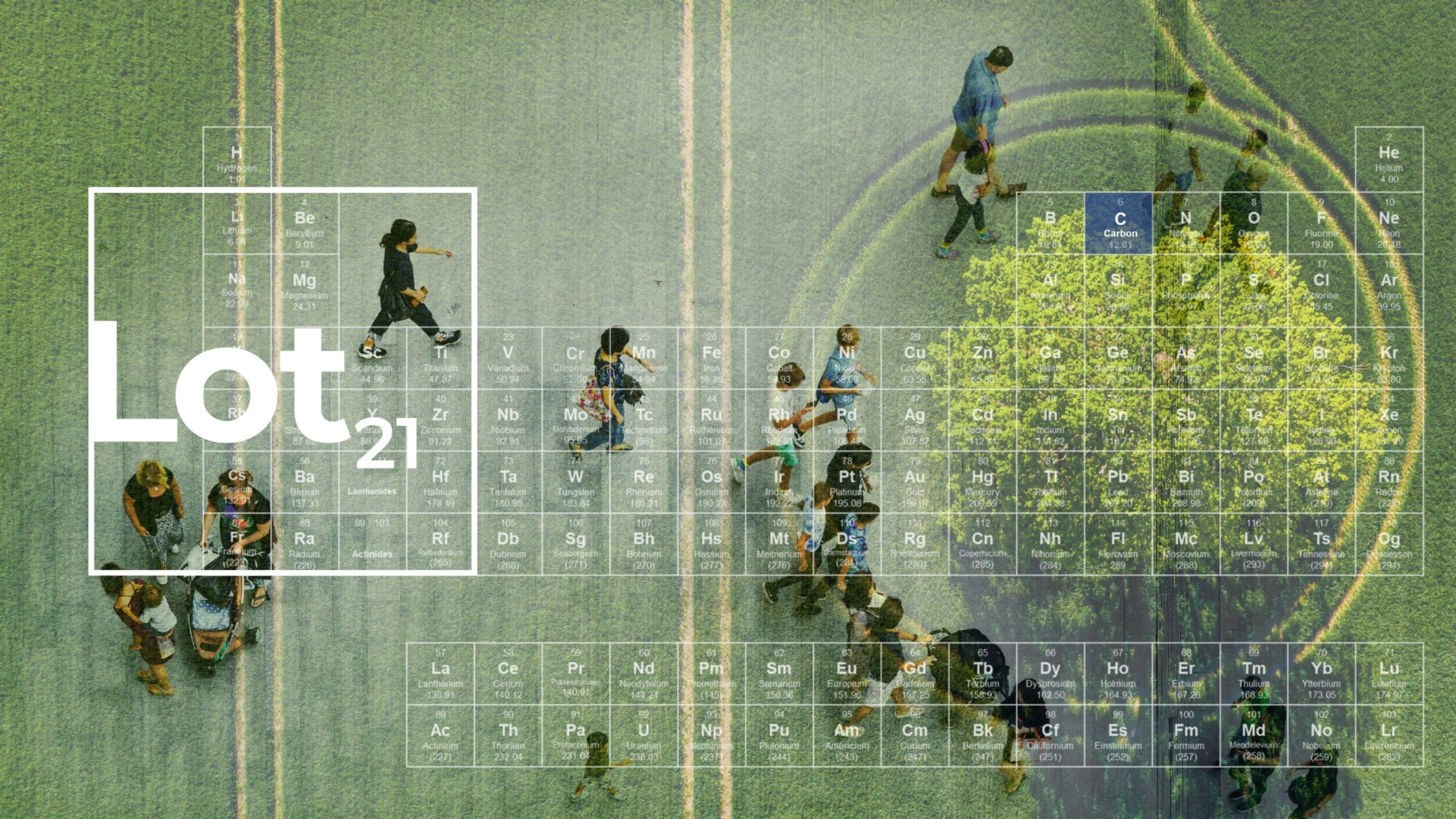
Changemakers: Lot21
26-Jun-2024
“Design is uniquely positioned to play a central role in counteracting the velocity of climate change.”
Lew Epstein is leading the launch of Lot21, a new content platform and resource to help the design community decarbonize the world — by advancing climate action across the built environment.
Interview #8 in the Changemaker series
For nearly 30 years, Lew Epstein led various brands at Steelcase, a global furniture company. His roles included directing and participating in research, marketing, sustainability and design, as well as starting an integrated technology group. Building on his extensive career, in 2023, Lew pivoted and founded Lot21.
In this interview, we ask Lew about climate solutions that present opportunities for designers and innovators, across the furniture industry and beyond, in the 21st century. We learn how CO2 – an invisible waste stream – can be captured, transformed and stored within pioneering products. And Lew identifies what Lot21 believes is needed at an individual, organizational and global level to advance innovation in the face of environmental decline.
This is the 8th in our Changemakers series – interviews with leaders in sustainable, circular and regenerative approaches in the furniture industry. Our aim is to uncover the nuts and bolts of how each leader is driving change, the potential it holds, and why it matters to the industry.

Lew Epstein, founder of Lot21
mebl: Lew, what motivated you to jump into the deep end of the climate battle?
Lew: It’s clear that we’re not keeping pace with the velocity of climate change. And we need to move a lot faster, which fuels me. What’s more, our habits around consumption make the race to keep pace with climate change particularly challenging. In a simple sense, the Earth’s natural resources are fairly finite, but our consumption is not. Unless we start to adjust how we think about consumption, follow circular design principles, and adopt its practices, our response to climate change will remain challenged.
mebl: Tell us about Lot21 and its fundamental way of framing the challenge.
Lew: Late last year, we launched Lot21 to ‘help the design community decarbonize the world.’ We believe design is uniquely positioned to play a central role in counteracting the velocity of climate change. Lot21 is a content platform and resource that seeks to inform, inspire, and empower the design community to advance climate action faster.
We use a climate-action framework that stands on three pillars: adaptation (climate resilience), mitigation (carbon reduction), and restoration (carbon removal). Adaptation helps resist the harmful effects of climate change by deploying more resilient solutions. Mitigation reduces the carbon-emitting sources in the built environment contributing to climate change. Restoration aims to return our climate to safe, preindustrial conditions by removing the excess carbon emissions accumulating in our atmosphere.
mebl: That’s huge. What’s your focus?
Lew: While we support all three climate actions, our primary focus is climate restoration and a diverse portfolio of rapidly-evolving carbon removal solutions. This area is less known yet critical to advancing a holistic approach to climate action.
Allow me to use a bathtub analogy to describe why carbon removal matters. If a bathtub represents our atmosphere, and it is overflowing with ‘emissions,’ then the first climate action would be to stop the tub from filling up. We turn down, and ultimately turn off, the faucets. This stops the flow of emissions into the bathtub – the atmosphere. Yet the tub remains full of carbon dioxide (CO2), which continues warming our planet. So, we must go further, emptying the tub to remove the excess CO2, which is necessary to restore our climate.
mebl: For the furniture industry, how is carbon removal and utilization applicable?
Lew: Well, let’s look at both stake and opportunity. Let’s talk first about ‘stake.’
Furniture companies using wood as a material feature or substructure, for example, likely have a stake in Forest Carbon Practices (see category listing #2 in the infographic, above). From one perspective, we all rely on the world’s forests to remove and store carbon dioxide through photosynthesis, a remarkable natural process.
But, from a furniture industry perspective, those who rely on wood to sustain their livelihoods have an even greater stake in sustaining this valuable resource. The good news is that sustainable forestry practices are well-established, and reforestation projects worldwide are easy to participate in. Designers can engage in such projects individually, collectively, and with clients who see such efforts as a tangible way to fulfill their climate pledges and ESG strategies.
Other natural carbon dioxide removal categories act as ‘carbon sinks’ as well, including oceans, coastal areas (salt marshes, sea grasses, and mangroves), and soil (see category listings #3, #4, and #5 in Lot21’s infographic to learn more). Designers in the furniture industry can participate in these types of projects, too, as a way to broaden their environmental design practices.
Those who design packaging may also be interested in learning more about the algae family, including seaweed and kelp, the largest seaweed subgroup. All algae form an important carbon sink, and new packing and wrapping solutions made from this rapidly renewable resource are readily available, with more in development.
In addition to these natural solutions, there are an ever-growing number of technological solutions, currently in varying stages of development and deployment. Among them is Direct Air Capture, which refers to technologies designed for removing excess CO2 from the atmosphere.
This leads to opportunities.

mebl: Yes, now please explain how CO2 waste can be an opportunity!
Lew: Like paper, metal, and plastic waste, CO2 forms a waste stream that can be captured and utilized as a recyclable material. We're all familiar with plastic pollution and how this wasteful and harmful material is collected from our oceans and waterways to be recycled and repurposed.
Similarly, greenhouse gasses have accumulated since the beginning of the industrial era and have peaked over the past half-century. Of the greenhouse gasses, CO2 is predominant - and large amounts of investment have gone into capturing it. But carbon removal is still not at its needed full capacity or scale, and the target price per removed ton of CO2 must be lower before we’ll see widespread adoption.
Yet all three of these measures are trending positively, so what can be achieved over the next few decades is promising. Like solar or wind technology – that took a few decades to mature – capturing carbon will become more affordable, effective, and mainstream in the decades ahead.
CO2 waste creates a new value stream that’s gaining great interest across the carbon community at a record pace. That’s opportunity.
For innovative companies, we really believe that carbon utilization creates a new frontier. The design and furniture industry could be prototyping, piloting, or producing with carbon waste today. Here’s an example - picture a shipping-container-sized structure with fans on the sides that draw in air through absorbent filters. The CO2 is captured in the filters and then safely stored deep underground, where it becomes mineralized or can be retained as a solid or liquid. These can be transformed into materials utilized for an ever-wider array of products, driving a new growth market, which I find exciting.
mebl: What kind of products can be made from CO2?
Lew: Captured carbon can be turned into a solid or liquid, so there are an unimaginable number of applications. In solid form, for example, it can be a plastic additive that replaces a fossil-based material used to make furniture hardware and components. Most of today's plastic is made with fossil-based materials, so captured and transformed carbon utilized in this way can become a climate-positive solution, given the prevalence of plastic.
Another application is carbon black - a pigment that can be used to dye textiles, footwear, electronics, plastics, inks, and paints. In liquid form, some companies have transformed CO2 waste into alcohol to be used in consumer products like perfume and vodka, and new ‘feedstocks’ for industrial products like sustainable aviation fuels. We see an emerging carbontech industry pushing the boundaries across product categories.

The vision of Lot21 emphasizes engaging design professionals in climate action.
mebl: What, at a local level, is needed to mainstream CO2 as a waste material?
Lew: We need partnerships and collaboration between innovators and companies with the right equipment and technology. We also need to take a long view, be patient, celebrate the wins – no matter how incremental they may be, and accept failures as part of the process.
Next, we need to continually learn from prototyping. This iterative process requires significant determination - as it's likely that not the first, but perhaps the third, fifth, or tenth prototype will be successful! Then, piloting. Running a pilot project in the factory, alongside your other proven and profitable lines, is crucial when bringing a new product to market. At this stage, you’re demonstrating a new way to participate in advancing climate action and inviting others to join. That’s significant in and of itself!
Year after year, new innovative solutions will gain greater adoption and gradually become mainstream. As this spreads, opportunities to participate at a local level will increase because the materials, equipment, and methods will become integrated and normalized.
A process like this can take a decade or more. Collaborating with suppliers lets them know there’s growing demand and interest in co-development. To mainstream carbon utilization, we need thousands of concepts that start as prototypes, and others that lead to pilot projects and new product lines.

mebl: What’s your advice to furniture companies interested in, or starting out, in climate action?
Lew: The good news is that we see signs that the furniture industry is recognizing that we’re in a climate crisis and wants to respond. Positive change is up to us. After acknowledging the problem, the next step would be to make a pledge - for instance, that your company commits to achieving net zero between 2030 and 2050.
Your pledge is a stake in the ground to be followed by a second step: developing a climate action plan describing the methods you intend to use to get from here to there. The third step is likely the hardest but most rewarding: turning a climate action plan into an ongoing practice that’s part of your business strategy and incorporates various forms of climate resilience, carbon reduction, and removal.
mebl: Tell us about purchasing carbon offsets as part of a company’s climate action plan?
Lew: If buying carbon offset credits is part of your initial plan, that’s alright. For those less familiar – a carbon offset is when a company purchases credits or invests in programs that reduce, avoid, or remove emissions to compensate for some of its own greenhouse gas emissions.
Purchasing carbon offsets can be an interim solution — like using training wheels. But you’ll want to remove them as soon as possible. After a pre-defined period of time, your company must be able to demonstrate that it’s winding down its offset purchases and implementing measurable carbon reduction and removal efforts of its own. Carbon offsets are part of the transition process; companies can’t switch overnight, but without acknowledging the use of carbon credits to delay making real progress, you’re greenwashing, frankly.
In the carbon community, MRV – measuring, reporting, and verifying – is important because it creates transparency and credibility and builds trust for investment purposes. It’s a relatively new field, with active engagement from both the private and public sectors working to establish global standards for MRV carbon accounting that industries can align around. It’s similar to the furniture industry’s accreditation programs that benefit from standard measurements, reporting, and 3rd party verification to build trust and value and avoid greenwashing.
mebl: For an individual designer eager to take a next step toward climate action - what’s your advice?
Lew: At a personal level, it depends – How do you think of your role as a citizen of our planet? At Lot21, we aim to help designers envision themselves as participants in climate advocacy and action. One route to greater involvement is to align with a local, state, national, or international affinity group tackling climate-related issues. Some examples here in New York City are Big Reuse, Queens Climate Project, and The Climate Museum. If you’re interested in national and international policy, our Lot21 website includes links to high-level overviews as well as to How to Participate and Resources sections by state within our National directory.
mebl: For the furniture industry, what interventions could catapult climate action to a whole new level?
Lew: First, we need collective action — an initiative through which the industry works collectively to move the needle faster. The furniture industry’s consumer, commercial, and industrial product categories contribute to the built environment’s carbon footprint, and the packaging in which all those products are wrapped and delivered contributes even more.
Every company’s material and process choices can make a difference in reducing and removing carbon. Working together as an industry – openly sharing best practices and resources – will help advance climate action faster. After all, proprietary single-company solutions cannot scale across an industry of competitors to reach their full potential in response to the climate crisis. It takes collective action.
Second, we need a collective tool to encapsulate the variety of fantastic new tools already in the industry. On Lot21, you can find multiple independent tools created by different design firms that fill a gap and industry need. We can imagine an eventual consolidation of these tools – with recognition of all the contributors – to standardize how information is measured, reported, and verified.
The furniture industry needs to establish standards that more industry members willingly follow, which leads to greater throughput and accomplishes more sooner. Think LEED – a global set of standards that incorporate updates to remain relevant. Think Project ECHO, an example of a cross-disciplinary effort now underway. Tools that establish fewer – yet no less trusted – standards can scale more easily and help us move the needle faster together.
Third, we need a collective of companies - for example, a buying consortium for small businesses. At the moment, the largest companies in the world have the buying power, and small companies that want to make change struggle to buy, for instance, more sustainable materials at volume prices. Smaller brands and manufacturers need the support of a consortium to gain collective scale and more purchasing power.
mebl: Are there other key dimensions to Lot21‘s vision of an effective action plan?
Lew: Yes, we need government support for a consortium of small companies with subsidies on new technology and materials – or offsets as a temporary transitory solution. Certain states, for example, have a ‘Buy Clean Policy’ for purchasing low-embodied carbon concrete. These state governments offer incentives that help subsidize a percentage of the price difference between low-embodied concrete and conventional concrete. State governments support this initiative until the low-embodied carbon material gains scale and becomes cost-competitive.
Finally, we hope that industry certifications and standards become more rigorous and easier to execute. At present, these processes are time-consuming, costly, and complex. We need more harmonization of standards across design disciplines, industries, regions, and countries. While some differences across disciplines and domains will remain necessary, we believe greater emphasis on what we have in common will help us advance climate action faster.
These would be three major steps toward transformative change across the furniture industry. As you know, I believe we can and must do more. That keeps me motivated!
-
Image Sources:
- Lot21 Website Design: 2Sisters Design
- Video + Imagery: StudioFYNN
READ more Changemaker Interviews here.
